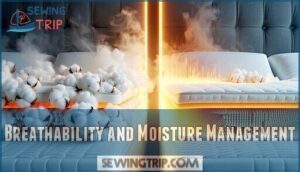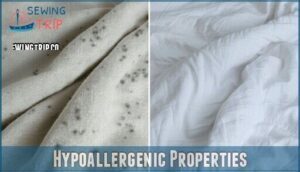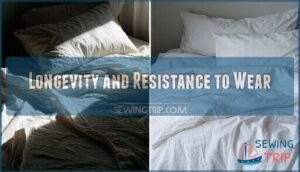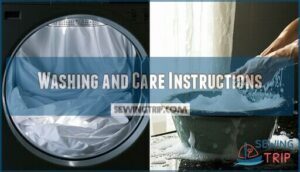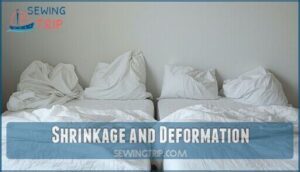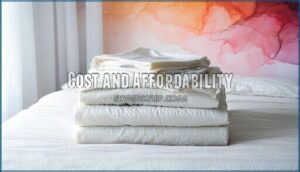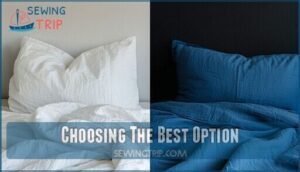This site is supported by our readers. We may earn a commission, at no cost to you, if you purchase through links.
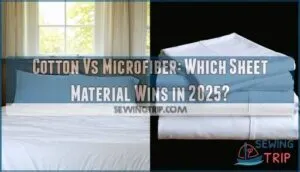
Cotton breathes better, keeping you cool through the night, while microfiber offers impressive durability and wrinkle resistance at a fraction of the cost.
Cotton feels softer against your skin and gets better with age, but microfiber handles daily washing without fading or shrinking.
If you’re a hot sleeper who values natural materials, cotton’s your best bet.
Budget-conscious buyers who want low-maintenance bedding will find microfiber hard to beat.
The real decision hinges on what matters most for your sleep sanctuary and lifestyle needs.
Table Of Contents
Key Takeaways
- Cotton’s your best bet for hot sleepers – It breathes naturally and wicks moisture away from your body, while microfiber traps heat and can make you sweaty throughout the night.
- Microfiber wins on durability and budget – You’ll spend $45-$70 versus $80-$150+ for cotton, and microfiber lasts 5+ years with wrinkle-free maintenance compared to cotton’s 3-5 year lifespan.
- Cotton gets softer with age, microfiber stays consistent – Your cotton sheets will feel better after each wash as the fibers soften, while microfiber maintains its original silk-like texture but won’t improve over time.
- Consider your skin sensitivity and environmental impact – Cotton’s naturally hypoallergenic and biodegrades within months, while microfiber can irritate sensitive skin and contributes to microplastic pollution for centuries.
Cotton Vs Microfiber
When you’re choosing between cotton and microfiber sheets, you’re comparing two completely different materials with distinct advantages.
Cotton comes from natural plant fibers that have been used for thousands of years, while microfiber is a synthetic blend typically made from polyester or nylon that was developed as a modern alternative to natural fabrics, offering distinct advantages.
Material Composition
Understanding the fundamental differences between cotton and microfiber starts with their material composition.
Cotton comes from natural fibers sourced directly from cotton plants, while microfiber represents synthetic materials made from polymer composition like polyester and nylon.
Some synthetic blends even incorporate wood pulp during manufacturing.
| Aspect | Cotton | Microfiber |
|---|---|---|
| Fiber Sourcing | Natural cotton plants | Synthetic polymers |
| Cotton Varieties | Egyptian, Supima, Regular | N/A |
| Synthetic Blends | N/A | Polyester, nylon, wood pulp |
| Material Type | 100% natural fibers | Fully synthetic fibers |
Origins and History
The cotton timeline traces back to ancient civilizations, while microfiber invention emerged during the 1950s as synthetic innovation.
The Industrial Revolution transformed textile production, making cotton commercially viable worldwide.
| Aspect | Cotton | Microfiber |
|---|---|---|
| Origin | 5th millennium B.C. | 1950s development |
| Revolution | Industrial boom era | Modern synthetic age |
| Evolution | Natural fiber refinement | Petroleum-based creation |
This fiber evolution showcases humanity’s textile journey from historical uses of plant-based materials to engineered alternatives.
Types of Cotton and Microfiber
Exploring sheet varieties reveals distinct options for every sleeper’s needs.
You’ll find cotton fabric ranging from basic Upland to luxury Egyptian cotton with extra-long staple fibers.
| Cotton Types | Microfiber Types |
|---|---|
| Egyptian Cotton (1.4-2" staple length) | Split Microfiber ( |
Softness and Comfort
When you’re choosing between cotton and microfiber sheets, comfort becomes the deciding factor that affects your sleep quality every single night.
Your skin will notice the difference immediately – cotton’s natural breathability keeps you cool while microfiber’s silky smoothness feels luxurious but can trap heat.
Breathability and Moisture Management
When you’re tossing and turning at night, breathability becomes your best friend.
Cotton excels at air circulation, allowing heat to escape while absorbing sweat naturally. Microfiber’s tight weave creates heat retention, trapping warmth that can cause skin irritation.
Your climate preference matters—cotton’s moisture-wicking properties suit hot sleepers, while microfiber works better in cooler environments where temperature regulation isn’t critical.
Other options, like rayon, offer moderate moisture-wicking at a lower cost.
Texture and Feel
Your tactile experience with bedding dramatically impacts sleep quality.
Cotton benefits include natural texture variations, while microfiber fabric offers consistent smoothness throughout its lifespan.
Here’s how cotton vs microfiber softness compares:
- Initial Softness: Microfiber benefits include immediate silk-like smoothness, while cotton starts firmer
- Long-term Feel: Cotton softens beautifully with each wash, microfiber maintains original texture
- Skin Sensitivity: Cotton’s natural fibers feel gentler against sensitive skin than synthetic alternatives
- Seasonal Comfort: Cotton’s varied weaves adapt to temperature changes better than uniform microfiber
Hypoallergenic Properties
When battling allergies, your sheet choice becomes essential for peaceful sleep.
Both materials offer distinct advantages for sensitive sleepers, but understanding their differences helps you make the right call.
| Feature | Cotton | Microfiber |
|---|---|---|
| Dust Mites | Natural resistance varies | Tight weave blocks allergens |
| Chemical Irritants | Minimal processing chemicals | May contain synthetic residues |
| Skin Sensitivity | Naturally hypoallergenic | Can cause static irritation |
Cotton’s natural fibers work well for most people with allergies, though dust mites can still find cozy homes in lower-quality weaves.
Microfiber’s dense construction creates a barrier against dust mites and common allergens, making it excellent for asthma concerns.
However, some folks experience skin sensitivity from microfiber’s synthetic nature and static buildup.
Durability and Maintenance
When you’re choosing between cotton and microfiber sheets, it’s smart to look at how they handle regular washing, wear, and life’s little spills.
You don’t want your bedding to fade, shrink, or pill before you’ve even finished paying off your mattress.
Longevity and Resistance to Wear
In the context of cotton vs microfiber durability, you’ll find some surprising differences.
Microfiber’s synthetic construction gives it superior pilling resistance and shape retention, often lasting 5+ years compared to cotton’s 3-5 year lifespan.
Microfiber sheets are known for their durability because of their resistance to pilling.
Here’s what really matters for your sheets’ longevity:
- Fiber degradation – Cotton weakens 25% under high heat, while microfiber maintains strength
- Wash durability – Quality microfiber withstands 300 washes versus cotton’s variable performance
- Wear and tear – Microfiber’s tight weave resists abrasion better than cotton’s natural fibers
Washing and Care Instructions
Microfiber care wins the convenience battle – toss these sheets in any wash temperature and they’ll bounce back wrinkle-free.
Cotton demands more attention: use cold water to prevent shrinkage, skip fabric softeners that reduce absorbency, and expect longer drying times.
For thorough guidance, it’s helpful to research specific care products.
Microfiber’s stain removal prowess means less pre-treatment, while cotton often needs targeted cleaning methods for stubborn spots to ensure proper care.
Shrinkage and Deformation
Before your sheets hit the washing machine, cotton shows its vulnerable side.
Cotton shrinkage occurs when hot water and high heat break down natural fibers, causing them to contract up to 10%.
Microfiber deformation rarely happens since synthetic fibers maintain their shape through countless washing cycles.
Heat sensitivity makes cotton tricky—cold water prevents shrinkage, while microfiber tolerates any temperature without losing its original dimensions, due to its synthetic fibers and natural properties being less prone to deformation.
Environmental Impact
When you’re choosing between cotton and microfiber sheets, the environmental impact might surprise you more than the price difference.
Both materials come with distinct ecological trade-offs that could influence your decision beyond just comfort and cost.
Production Process and Chemicals
Understanding the production processes reveals significant differences between these materials.
Cotton production relies heavily on agricultural chemicals, while microfiber manufacturing depends on industrial processes and petrochemicals.
Here’s how chemical production impacts each material:
- Cotton pesticides and chemical fertilizers contaminate soil and waterways during farming
- Synthetic dyes and solvents create hazardous waste in textile manufacturing facilities
- Chemical runoff from both processes threatens local ecosystems and communities
Production energy requirements differ dramatically—microfiber manufacturing consumes more energy than cotton processing, though both involve substantial water usage and chemical treatments.
Biodegradability and Waste Management
Cotton’s end-of-life journey differs dramatically from microfiber’s environmental legacy.
Cotton biodegrades within months, transforming into harmless compost that enriches soil.
Meanwhile, microfiber persists for centuries, contributing to microplastic pollution in waterways.
You’ll find cotton’s recycling viability limited but manageable, while microfiber’s landfill impact creates lasting environmental concerns requiring sustainable alternatives.
Carbon Footprint and Sustainability
When evaluating carbon footprint and sustainability, microfiber packs a heavier environmental punch than cotton.
Microfiber production generates approximately 3.5 kg CO2 equivalent per kilogram, nearly double cotton’s 1.8 kg emissions.
However, recycled polyester microfiber can slash carbon emissions by 75%.
Cotton sustainability improves dramatically with organic farming, reducing water usage by 91% and eliminating pesticide impact, while microfiber sustainability faces ongoing microplastic pollution challenges.
Cost and Affordability
In terms of your wallet, the difference between cotton and microfiber sheets is significant.
The cost of quality microfiber sets typically ranges from $45-$70, while comparable cotton bedding ranges from $80-$150 or more.
This makes microfiber the clear winner for budget-conscious shoppers.
Price Range and Quality
When shopping for sheets, you’ll find striking differences between cotton and microfiber pricing that directly impact fabric quality and long-term satisfaction.
- Microfiber price range: $45-$70 for quality sets, offering consistent affordability with stable pricing that won’t fluctuate like cotton markets
- Cotton price variations: $80-$150+ for comparable quality, with premium Egyptian cotton reaching luxury territory due to natural fiber processing costs
- Quality vs. Cost balance: Higher-priced cotton delivers superior breathability and durability, while budget-friendly microfiber provides reliable performance at lower price points
- Price Fluctuation factors: Cotton prices swing based on harvest conditions and thread counts, whereas microfiber maintains predictable synthetic material costs
- Budget Considerations for shoppers: Microfiber offers immediate cost-effectiveness, while cotton represents affordable luxury that justifies higher upfront investment through enhanced comfort and longevity
Value for Money and Long-term Investment
When comparing long-term cost versus initial price, microfiber’s lower upfront investment of $45-$70 often masks cotton’s superior value proposition.
High-quality cotton’s 3-5 year lifespan and improving softness with each wash typically outweigh microfiber’s 5+ year durability. Cotton’s replacement frequency depends on thread count, making premium varieties cost-effective investments despite higher cotton prices compared to consistent microfiber pricing.
To save money, consider repurposing old fabrics for sewing projects, which can be a practical solution and help reduce waste by finding new uses for existing materials, thus embracing a more sustainable approach.
Budget-friendly Options and Alternatives
Budget-savvy shoppers can find quality bedding without breaking the bank.
Smart shopping strategies yield significant savings on both cotton and microfiber sheets.
Consider these cost-effective approaches:
- Discount retailers offer affordable materials at 40-60% lower prices than department stores
- Secondhand options provide high-quality cotton sheets for a fraction of the original cost
- DIY bedding projects using fabric remnants create custom solutions under $30
- Seasonal sales deliver premium materials at budget-friendly prices during clearance events
Many shoppers also search for affordable sheet options.
Choosing The Best Option
When picking between cotton and microfiber sheets, you’ll want to take into account your sleep habits, budget, and personal preferences.
Your choice comes down to whether you prioritize natural breathability and long-term comfort or prefer low-maintenance convenience and immediate affordability.
Considerations for Sleep and Comfort
Your sleep quality hinges on finding sheets that match your sensory preferences.
Hot sleepers need cotton’s breathability for restful sleep, while those with skin sensitivity should consider cotton’s hypoallergenic nature.
Shoppers often seek high thread count for superior comfort.
Your bedtime routine and sleep temperature requirements guide this choice.
| Factor | Cotton | Microfiber |
|---|---|---|
| Temperature Control | Excellent breathability, keeps you cool | Can trap heat, warmer feel |
| Comfort for Sensitive Skin | Hypoallergenic, gentle on skin | May cause irritation for some |
| Sleep Quality Impact | Natural feel promotes deeper rest | Smooth texture, less breathable |
Lifestyle and Personal Preferences
Your lifestyle preferences shape which fabric works best for your daily routine.
Consider how you live, sleep, and prioritize comfort when making this decision.
- Sleeping Habits: Hot sleepers benefit from cotton’s breathability, while cold sleepers might prefer microfiber’s warmth retention
- Climate Preference: Humid environments favor cotton’s moisture-wicking properties; dry climates work well with either fabric
- Aesthetic Choices: Cotton offers varied textures and weaves; microfiber provides consistent smoothness and wrinkle resistance
For enhanced longevity, consider fabric weight considerations when selecting sheets.
Health and Allergy Concerns
If you suffer from allergies or have sensitive skin, cotton wins hands down.
Cotton’s natural fibers are hypoallergenic and resist dust mites better than synthetic microfiber.
Microfiber can trap allergens and may cause respiratory issues for allergy sufferers due to chemical exposure during manufacturing.
Cotton breathes naturally, reducing allergen accumulation that triggers reactions.
Frequently Asked Questions (FAQs)
How often should you change your sheets?
You’ll want to change your sheets weekly for ideal cleanliness and comfort. If you’re sick, sweat heavily, or have allergies, consider switching them twice weekly for better hygiene.
What kind of sheets do hotels use?
Like a signature cotton thread woven through luxury linens, hotels overwhelmingly choose cotton percale sheets for their crisp, cool feel and durability, providing that rejuvenating sleep experience guests crave.
What kind of sheets are crisp?
Crisp sheets come from percale weaves and lower thread counts. You’ll find cotton percale offers that hotel-fresh feel with breathable, cool-to-the-touch texture that stays structured and smooth after washing.
What kind of sheets are best for hot sleepers?
Cotton sheets are your best bet for hot sleepers.
They’re naturally breathable, allowing air to circulate and wick moisture away from your body, preventing overheating and night sweats throughout the night, with naturally breathable properties being key to their effectiveness.
What are Tencel sheets?
Tencel fibers can absorb up to 44% of their weight in moisture, making them excellent for temperature control.
Tencel sheets are made from wood pulp, creating soft, breathable, and naturally hypoallergenic bedding that’s cooler to the touch than cotton.
Which is best, cotton or microfiber?
Your best choice depends on your priorities. Cotton wins for breathability and natural comfort, especially if you’re a hot sleeper. Microfiber offers better durability and affordability with easier care.
Is microfiber better for skin than cotton?
Natural fibers breathe better, synthetic materials trap heat—but for sensitive skin, cotton’s your best bet. It’s hypoallergenic and gets softer with each wash, while microfiber can feel scratchy.
What is better for your hair, cotton or microfiber?
Microfiber’s smoother surface creates less friction against hair strands than cotton, reducing breakage and frizz while you sleep.
Your hair will thank you for choosing microfiber pillowcases over traditional cotton ones.
What are the disadvantages of microfiber fabric?
You’ll face heat retention issues since synthetic fibers trap warmth, making you sweaty. They’re less breathable than natural materials, create microplastic pollution, and can feel artificial against your skin.
Can microfiber sheets cause static electricity buildup?
Static cling transforms your bedroom into a crackling science experiment.
Yes, microfiber sheets definitely cause static buildup because synthetic fibers don’t conduct electricity like natural materials.
You’ll notice more sparks during dry winter months when humidity drops below comfortable levels, leading to increased static buildup.
Conclusion
Ready to make your final decision in the cotton vs microfiber debate?
Your choice ultimately depends on your specific needs and priorities.
Cotton wins for breathability, natural comfort, and long-term softness, making it ideal for hot sleepers who prefer organic materials.
Microfiber excels in durability, affordability, and low maintenance, perfect for busy households on a budget.
Consider your sleep temperature, budget constraints, and environmental concerns when choosing between these materials.
Both options offer quality sleep solutions—you’ll just need to match the right material to your lifestyle.
- https://cottontoday.cottoninc.com/our-sustainability-story/microfibers/
- https://geopelie.com/en/blogs/blog/the-environmental-impact-of-the-different-textile-fibers
- https://www.cleanmo.com/a-microfiber-vs-natural-cotton-comparison-of-100-sets-of-laboratory-decontamination-data.html
- https://www.paragongroup.co.uk/cotton-versus-microfibre-pros-and-cons/
- https://gokottalifestyle.com/blogs/news/microfiber-vs-cotton-bed-sheets-apartment-living-guide

